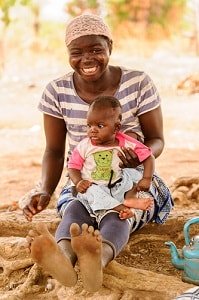
Most babies learn to sit up by themselves sometime between 4 and 8 months. But the process is gradual, and some babies make faster progress than others. We can give motor development a boost by helping babies build key muscles.
When do babies sit up by themselves? There isn’t any one, universal answer.
Around the world, approximately half of all babies have learned to sit independently by the age of 6 months. But some babies reach this milestone much earlier — as early as 4 months. And other babies take much longer — 8 months or more.
Why does the timing vary so much?
To some degree, the timing depends on genetics.
For example, some babies might be born with a genetic tendency to be more physically active. As a consequence, they get more exercise, and this helps them learn new motor skills at a raster pace.
But it’s also evident that the environment matters. Quite a lot!
For instance, in a study of infants living in the United Kingdom, researchers found that approximately half the variation in the timing of sitting was caused by differences in the environment. Some children were growing up in environments that favored earlier development (Smith et al 2017).
So what’s considered normal? When should a parent be concerned about the possibility of a developmental delay?
Experts offer this rule of thumb: If your baby hasn’t begun to sit up by the age of 9 months, talk to your doctor. Your doctor can screen your baby for problems. If something’s not right, early intervention will help your baby get back on track.
But there’s nothing magical about 9 months. If you see something that bothers you — if something seems off — you shouldn’t wait until 9 months. Especially if your baby is approaching the 9 month mark and seems to have trouble sitting with support. Trust your instincts and consult your doctor.
And if your baby is older than 9 months? That doesn’t mean your baby has a developmental problem. For many infants, taking longer is just a reflection of their personal quirks and experiences. As we’ll see below, babies learn to sit up earlier when they get more opportunities to practice. And we can do a great deal to help them.
So why the focus on 9 months? And where do these other numbers come from? How do we know what’s typical or normal?
Ultimately, the numbers come from scientific surveys. Researchers recruit families with young infants, and track development over time. Parents report when their babies achieve certain motor milestones.
For example, in one study, the World Health Organization tracked more than 1,100 babies in six different countries.
Every month, researchers asked parents about their infants’ motor development. And after all the data were collected, researchers found that approximately 95% of the babies had learned to sit up (unassisted) sometime between the ages of 4.3 months and 8 months. About half of all babies in the study had learned to sit up independently by the age of 5.9 months (Matorell et al 2006).
So it’s numbers like these that experts use to make generalizations about what to expect. They aren’t numbers that tell us what “should” happen. They are numbers that tell us what actually happened…among babies participating in a specific study.
And here’s what’s interesting: We can get very different numbers depending on where we look.
The “normal” or “typical” age range for sitting up isn’t the same in every county. It varies. Sometimes pretty dramatically. And the variation maps onto what we know about local parenting practices.
To see what I mean, consider the West African country of Ghana.

Image of Ghanaian mother and baby by Anton Ivanov
In Ghana, parents don’t wait passively for their babies to experiment with new motor skills!
Like parents in many other African and Caribbean countries, they actively train their babies. For example, caregivers use their hands and supportive objects to help young infants practice sitting in an upright position (Adolf et al 2010; Karasik et al 2015). And the outcome?
In Ghana, the average (mean) age for learning to sit up independently is approximately 5.1 months. Around 95% of babies in Ghana reach the milestone between the ages of 3.5 and 6.7 months.
By contrast, let’s take a look at a country in Northern Europe — Norway. Parents in Norway usually take a more “wait and see” approach to physical development. They don’t coach their children to sit upright, and the outcomes are quite different:
In the World Health Organization study, the average Norwegian baby didn’t begin sitting up independently until about 7 months. And roughly one-third of babies didn’t reach the milestone until they were at least 8 months old (Matorell et al 2006).
So if we used data from Ghana to evaluate Norwegian babies, we might think that Norway is plagued by developmental problems. One third of Norwegian babies are so slow they fall outside what we might call the “normal range of variation” in Ghana.
But are these babies suffering from a medical condition? Are they challenged by a disease, or a physical disability, or a cognitive disorder?
In most cases, no. They’re just taking longer — most likely because they haven’t had the same opportunities to practice and develop their motor skills.
How, then, can you boost infant motor development? How can you help your baby learn to sit up?
The key is to provide your baby with the right sort of physical activities — activities that recognize your baby’s current limitations, but also encourage your baby to push those limits.
Where to begin? It’s helpful to understand the basic challenge that babies face.
To sit upright, babies need to something called “trunk control.” They need to build strength in core muscles throughout the neck, torso, and spinal column. And they develop this strength one segment at a time, in a specific, “top-down” sequence (Pin et al 2019):
- First, they build strength in their neck muscles.
- Next, they begin developing stronger muscles in the upper (thoracic) region of the torso.
- Then — once they’ve developed a strong thoracic region — they start building up the muscles of the lower trunk (the lumbar region).
Many parents seem to have an intuition about this sequence. You can see it when they hold their babies upright.
When a baby is very young and weak, parents typically hold onto the baby at the shoulders. But as the baby gets stronger, parents hold onto the upper or mid-back. And when a baby is nearly ready to sit up unsupported, parents place their hands around the lower back or hips.
So if you pay attention to your baby’s wobbles, you’ll quickly get a feeling for where your baby is in the sequence. You’ll have a sense of which muscles are already strong, and which muscles need conditioning.
Here are some things you can do at each stage of the process.
Six tips for teaching babies to sit upright
1. Help your baby develop strong neck muscles with “tummy time.”

Safety experts urge us to place young infants on their backs for sleeping. This tactic reduces the risk of SIDS. But when babies are awake and alert, they benefit from supervised sessions on their stomachs — especially if their caregivers make it a fun, social experience.
Such “tummy time” can speed up the development of certain locomotor skills, like crawling. And because tummy time gives babies the opportunity to develop greater muscle control and neck strength, it may help babies prepare for sitting up by themselves (Kuo et al 2008; Hewitt et al 2020).
Does your baby dislike being placed on the floor? As an alternative, try lying down and place your baby on your chest.
2. Help your baby strengthen core muscles of the torso with more tummy time, and with opportunities to roll around.

Rolling over is another one of those motor milestones that can vary a lot in timing: Some babies can do it before 3 months. Others may take 6 months.
But whenever it happens, it’s a big step in the direction of being ready to sit up. That’s because rolling around builds the strong, core muscles that babies need to stabilize themselves in an upright position.
3. Give your baby a taste of what it feels like to sit up. Become a living chair.

This is a common technique in cultures where parents take a proactive approach to motor development (Adolph et al 2010). Newborns aren’t just cradled and carried. They are also placed upright, in a sitting position, on their caregivers’ laps. The adult holds the baby in place, and becomes a kind of living chair — one that the baby can lean against.
4. Is your baby strong enough to hold up his or her own head? And able to keep the upper back region vertical and steady? Then your baby may be ready to try brief, supervised sessions of supported sitting on the floor.

Want to follow another cue from “proactive” cultures? Try seating your baby on the ground, with furniture, cushions, or other props to keep your baby from toppling over (Karasik et al 2015).
If you try this, your baby should already have strong neck muscles, and you should have noticed that your baby is beginning to develop control in the upper thoracic region (see above).
Also, remember not to leave your baby alone. This is something you and your baby will be doing together. And when you first begin these sessions, they will be very brief.
Your baby is learning to cope with gravity, learning how to counteract every little tug and tilt. Staying upright requires instantaneous adjustments in the stiffness of many different muscles. It’s quite a trick!
So when your baby moves away from his or her supports, it’s no wonder if your baby can only stay upright for a few seconds at a time. But those moments — however fleeting — are long enough to make a difference. With practice and exercise, your baby will develop more strength in the muscles of the thoracic and lumbar regions, and be capable of longer bouts of supported sitting.
5. Watch for “tripod sitting” — an early stage of sitting up where babies use their arms to prop themselves up.

Now “tummy time” is better termed “floor time,” because your baby is capable of sitting up by him or herself — at least for brief periods of time. At first, your baby’s stance will probably look rather bent or hunched forward , and your baby may require both hands on the ground to stay upright.
But your baby will begin to experiment with lifting one hand, and slowly learn how to adjust his or her balance. You can encourage this process by playing with your baby face-to-face, and offering your baby interesting objects to hold. And this brings us to my last suggestion…
6. Understand how your baby’s world is changing. Be ready to provide your baby with new learning opportunities!

Sitting up, unsupported, is more than a motor milestone. It’s also a trigger for new environmental experiences — experiences that can give your child a cognitive boost.
Once babies can sit up — without having to use their hands to keep their balance — it’s easier for them to reach for objects. It’s also easier for them to manipulate and visually examine objects, and that helps them learn about objects (Woods and Wilcox 2013).
It’s also likely that sitting up helps babies learn language. It’s easier for them to make eye contact, and this can stimulate more face-to-face conversation with their caregivers. They get exposed to more words, and begin learning new vocabulary at a faster pace (Libertus and Violi 2016).
So be ready to provide your baby with the stimulating social and cognitive rewards of sitting. Don’t leave your baby alone in chair with nothing to do. Encourage your baby to investigate, observe, communicate, and learn.
More reading about your baby’s development
Do you have other questions about your baby’s development? Check out these Parenting Science articles:
- Motor milestones: How do babies develop during the first two years?
- When do babies crawl, and how does crawling develop (illustrated guide)
- When do babies start walking, and how does it develop?
- When do babies say their first words?
- Talking to babies: How eye contact helps infants tune in
References
Adolph KE, Karasik LB, Tamis-LeMonda CS. 2010. Motor skills. In: Bornstein MH, editor. Handbook of cross-cultural development science. Vol. 1. Domains of development across cultures, pp. 61–88 Hillsdale, NJ: Erlbaum.
Gonzalez SL, Alvarez V, Nelson EL. 2019. Do Gross and Fine Motor Skills Differentially Contribute to Language Outcomes? A Systematic Review. Front Psychol. 10:2670.
Hewitt L, Kerr E, Stanley RM, Okely AD. 2020. Tummy Time and Infant Health Outcomes: A Systematic Review. Pediatrics. 145(6):e20192168.
Karasik LB, Tamis-LeMonda CS, Adolph KE, and Bornstein MH. 2015. Places and postures: A cross-cultural comparison of sitting in 5-month-olds. J Cross Cult Psychol. 46(8):1023-1038.
Kuo YL, Liao HF, Chen PC, Hsieh WS, Hwang AW. 2008. The influence of wakeful prone positioning on motor development during the early life. J Dev Behav Pediatr. 29(5):367-76.
Libertus K, and Violi DA. 2016. Sit to Talk: Relation between Motor Skills and Language Development in Infancy. Front Psychol. 7:475.
Martorell R, Onis M, Martines J, Black M, Onyango A, Dewey KG. 2006. WHO motor development study: Windows of achievement for six gross motor development milestones. Acta Paediatrica. 95(S450):86–95.
Oudgenoeg-Paz O, Leseman PP, Volman MC. 2015. Exploration as a mediator of the relation between the attainment of motor milestones and the development of spatial cognition and spatial language. Dev Psychol. 51(9):1241-53.
Oudgenoeg-Paz O, Volman MC, Leseman PP. 2012. Attainment of sitting and walking predicts development of productive vocabulary between ages 16 and 28 months. Infant Behav Dev. 35(4):733-6.
Pin TW, Butler PB, Cheung HM, Shum SL. 2019. Relationship between segmental trunk control and gross motor development in typically developing infants aged from 4 to 12 months: a pilot study. BMC Pediatr. 19(1):425.
Smith L, van Jaarsveld CHM, Llewellyn CH, Fildes A, López Sánchez GF, Wardle J, Fisher A. 2017. Genetic and Environmental Influences on Developmental Milestones and Movement: Results From the Gemini Cohort Study. Res Q Exerc Sport. 88(4):401-407
Valla L, Slinning K, Kalleson R, Wentzel-Larsen T, Riiser K. 2020. Motor skills and later communication development in early childhood: Results from a population-based study. Child Care Health Dev. 46(4):407-413.
Valla L, Wentzel-Larsen T, Hofoss D, Slinning K. 2015. Prevalence of suspected developmental delays in early infancy: results from a regional population-based longitudinal study. BMC Pediatr. 15:215.
Woods RJ and Wilcox T. 2013. Posture support improves object individuation in infants. Developmental Psychology 49(8): 1413–1424.
Saavedra SL, van Donkelaar P, Woollacott MH. 2012. Learning about gravity: segmental assessment of upright control as infants develop independent sitting. J Neurophysiol. 108(8):2215-29.
Valla L, Wentzel-Larsen T, Hofoss D, Slinning K. 2015. Prevalence of suspected developmental delays in early infancy: results from a regional population-based longitudinal study. BMC Pediatr. 15:215.
Title image of three babies sitting by Rawpixel / istock
Image of Ghanaian mother and infant by Anton Ivanov / shutterstock
Image of father with baby on floor by FlamingoImages / istock
Image of baby rolling over by Gwill / Shutterstock
Image of mother being a living chair for infant by RobertoDavid / istock
Image of baby sitting on floor, propped up on pillows by Sasiistock / istock
image of baby sitting in a tripod stance by Tracey Newman / istock
Image of mother with baby in a park by MonkeyBusinessImages / Shutterstock
Content last modified 12/2020